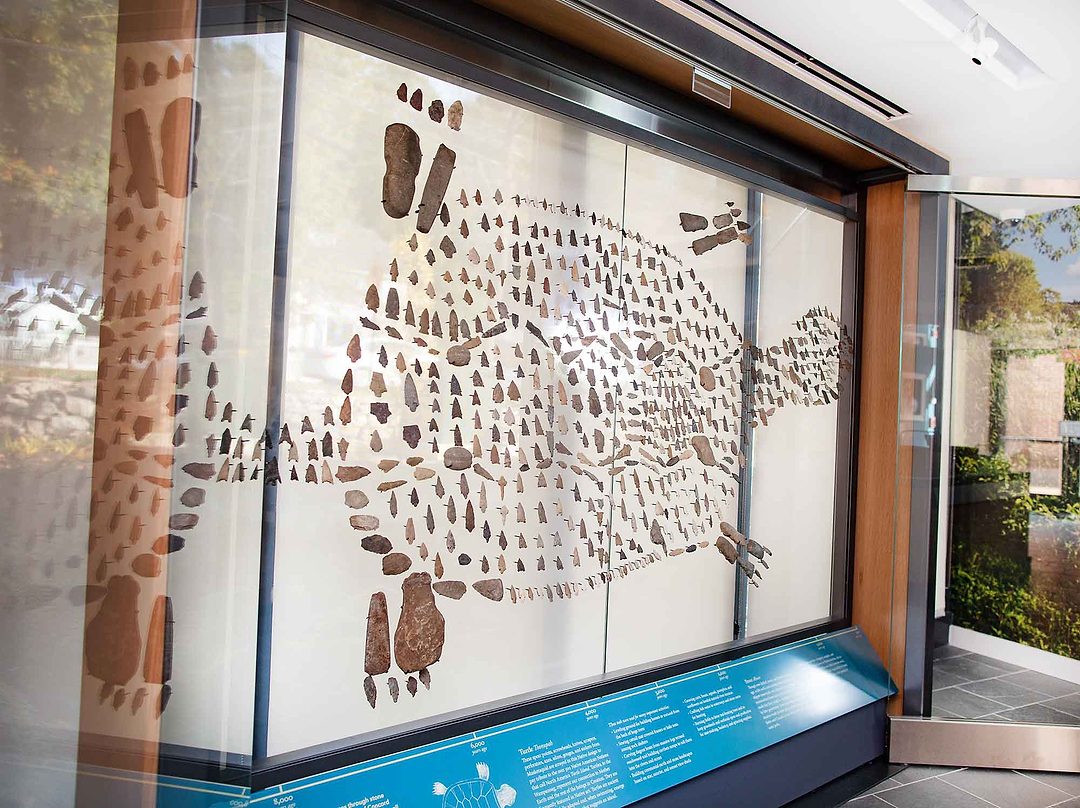You see the names all over town: Musketaquid, Nashawtuc, Nashoba, Squaw Sachem. These words invite us to learn the stories of the people who lived in this place for thousands of years before English settlers arrived.
The English named this place Concord in 1635, but it had long been known by the region’s first peoples as Musketaquid. In the Algonquian language, the name means “grassy river” or “grassy island,” and the Sudbury, Assabet, and Concord Rivers have always been the lifeblood of the land. As Lemuel Shattuck recounts in his 1835 History of Concord, the local people lived “[by] planting, hunting, or fishing . . . and few places produced a supply more easily than Musketaquid.” 1
Archaeological evidence shows that humans lived here as long as 12,000 years ago, migrating into the region from the west after the last Ice Age. At first, people lived here only part of the year, following the fish and game. Freshwater mussels were a favorite food, as we know from the vast number of shells discovered near the present site of Emerson Hospital. Their diet also included deer, turkey, muskrat, alewife, salmon, and eel, as well as a variety of nuts, fruits, and berries.2

Around 8,000 years ago, local activity expanded to new areas including Fairhaven Bay, Walden Pond, and present-day Lexington Road and Bedford Street.
A popular misconception about the Indigenous peoples of North America is that their way of life scarcely changed from the Stone Age until first contact with Europeans. In fact, the Musketaquid people made game-changing innovations. Around 1,600 years ago they adopted the bow and arrow, and about 1,000 years ago they began to practice agriculture in the areas of Punkatasset, North Bridge, South Bridge, and Nashawtuc (“hill between the rivers” in the Algonquian language).
A Nipmuc folktale tells of a crow who gave the people seeds and taught them how to grow corn, beans, and squash. In exchange, the story says, the crows return every year at harvest time to claim their share of the corn.3
In reality, it’s likely that new practices like bow hunting and farming were learned from other tribes with whom the Musketaquid people traded. These trade networks extended hundreds of miles; Tahattawan—the sagamore, or local chief, of Musketaquid—is said to have had an axe made of stone found in upstate New York.4
Visitors often ask about the tribal heritage of the Musketaquid people. It’s impossible to say conclusively, because tribal territories had porous boundaries, unlike the hard lines drawn by the English settlers. Musketaquid adjoined Nipmuc territory to the west, Penacook territory to the north, Pawtucket to the northeast, and the Massachusetts tribe to the southeast. Archeologist and anthropologist Shirley Blancke thinks it likely that the people living here in the early 1600s were of Pawtucket lineage.5
When English settlers arrived in Massachusetts in 1620, they built their first towns on the coast. To maintain their balance of trade with the mother country, they needed a local commodity that was in demand in England, and “the fur trade was the life blood of the Massachusetts Bay Colony.”6 An English fur trader, Simon Willard, ventured inland to Musketaquid to buy beaver pelts, and became so familiar with the place, the people, and the Algonquian language, that in 1635 he and Puritan minister Peter Bulkeley led the first party of English men and women to settle in the place they called Concord.
The native population had been drastically reduced by a smallpox epidemic in 1633, so perhaps it seemed like there was room for everybody, but in 1637 the English decided to formalize their ownership of the land. A sign near Monument Square marks the site where, according to tradition, Willard and Bulkeley sealed their agreement with the sagamore Tahattawan; the tribal leader we know only by her title, Squaw Sachem (Shattuck calls her “the great queen of the tribe”7); and her husband, the shaman Webcowet.

The English gave the Musketaquid people metal tools, European textiles and clothing, and “a parcel of Wampumpeage,”8 which they understood to purchase them ownership of six miles square of land. The native people saw themselves as living on the land, but didn’t believe anyone could own it, so they likely didn’t realize until it was too late that the English expected them to move out.
At first, the English seemed to be good neighbors to the Musketaquid people. They added native crops like corn and pumpkins to their menu, and found the local beans to be better for their health than the English variety. They bought Indian-made brooms and baskets, and “both men and women . . . acquired a pipe-smoking habit.”9
In the 1640s, John Eliot, an English minister, launched a mission to convert the native people to Christianity. He believed this was necessary to save them from the fires of hell, but of course it also taught them to respect English culture and values, so they might side with the English against their more intransigent kin. Eliot established a community of Christian Indians called Nashoba in 1651, at present-day Littleton. He placed John Tahattawan—whose father had sold Musketaquid to the English—in charge of the Nashoba community.
The fragile alliance between the English and the so-called praying Indians at Nashoba lasted until 1675, when the Wampanoag sachem Metacom (called King Philip by the English) led attacks to try to drive out the English settlers in southern New England. The conflict, known as King Philip’s War, spread across the region. The Nashoba people were moved into Concord, where John Hoar sheltered them on his property (the present site of Orchard House10). His frightened neighbors “secretly arranged for a soldier of ill repute, Captain Moseley, to come and forcibly remove the Nashoba Indians to Deer Island.” 11
We can’t erase that shameful chapter in Concord’s history. But we can honor the first people to cherish this land as their home. The Concord Museum has an extensive collection of native artifacts as much as 10,000 years old, and many of them can be seen in the People of Musketaquid gallery that opened in 2019. Designed in collaboration with Aquinnah Wampanoag consultant Elizabeth James-Perry and Shirley Blancke, it showcases this work not as relics of an extinct past, but as the history of a living people with a vibrant culture.
Educator Barbara Robinson shared this insight from that culture: “Socially inclusive, [native people] did not view the first settlers as strangers, but welcomed them.”12 Such inclusiveness is a lesson worth learning.
NOTES
1 Shattuck, Lemuel. A History of the Town of Concord … Boston, Russell, Osborne, and Co., 1835. 2 Blancke, Shirley and Robinson, Barbara, From Musketaquid to Concord, The Native and European Experience, Concord Museum, 1985. 3 Ibid. 4 Ibid. 5 Blancke, Shirley, Concord and Native First People, in New Perspectives on Concord’s History, Massachusetts Foundation for Humanities and Public Policy, 1983. 6 Ibid. 7 Shattuck, op. cit. 8 Ibid. Wampumpeag, or wampum, was the native currency, consisting of cylindrical beads made from seashells. 9 Blancke, Concord and Native First People. 10 Wheeler, Ruth R., Concord: Climate for Freedom, Concord Antiquarian Society, 1967. 11 Blancke, Concord and Native First People. 12 Blancke and Robinson, From Musketaquid to Concord.


